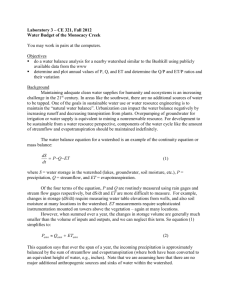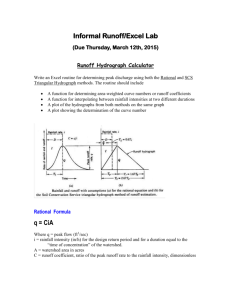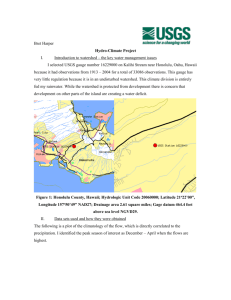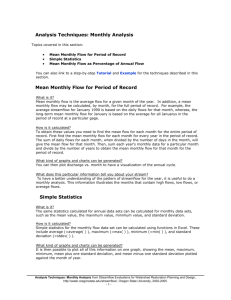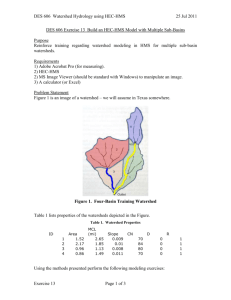ROBERT R. ZIEMER & RAYMOND M. RICE
advertisement
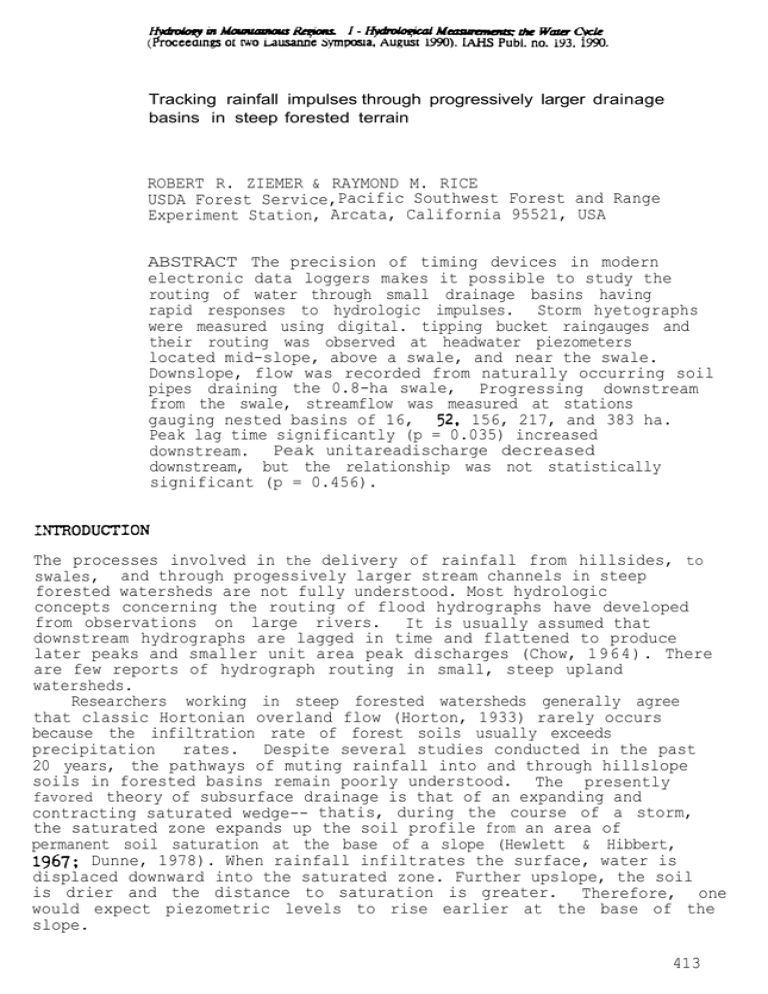
Tracking rainfall impulses through progressively larger drainage basins in steep forested terrain ROBERT R. ZIEMER & RAYMOND M. RICE USDA Forest Service,Pacific Southwest Forest and Range Experiment Station, Arcata, California 95521, USA ABSTRACT The precision of timing devices in modern electronic data loggers makes it possible to study the routing of water through small drainage basins having rapid responses to hydrologic impulses. Storm hyetographs were measured using digital. tipping bucket raingauges and their routing was observed at headwater piezometers located mid-slope, above a swale, and near the swale. Downslope, flow was recorded from naturally occurring soil pipes drainingg the 0.8-ha swale, Progressing downstream from the swale, streamflow was measured at stations gauging nested basins of 16, 156, 217, and 383 ha. Peak lag time significantly (p = 0.035) increased downstream. Peak unitareadischarge decreased downstream, but the relationship was not statistically significant (p = 0.456). The processes involved in the delivery of rainfall from hillsides, to swales, and through progessively larger stream channels in steep forested watersheds are not fully understood. Most hydrologic concepts concerning the routing of flood hydrographs have developed from observations on large rivers. It is usually assumed that downstream hydrographs are lagged in time and flattened to produce later peaks and smaller unit area peak discharges (Chow, 1964). There are few reports of hydrograph routing in small, steep upland watersheds. Researchers working in steep forested watersheds generally agree that classic Hortonian overland flow (Horton, 1933) rarely occurs because the infiltration rate of forest soils usually exceeds precipitation rates. Despite several studies conducted in the past 20 years, the pathways of muting rainfall into and through hillslope soils in forested basins remain poorly understood. The presently favored theory of subsurface drainage is that of an expanding and contracting saturated wedge---thatis, during the course of a storm, the saturated zone expands up the soil profile from an area of permanent soil saturation at the base of a slope (Hewlett & Hibbert, 1967; Dunne, 1978). When rainfall infiltrates the surface, water is displaced downward into the saturated zone. Further upslope, the soil is drier and the distance to saturation is greater. Therefore, one would expect piezometric levels to rise earlier at the base of the slope. 413 Robert R. Ziemer & Raymond M. Rice 414 However, the presence of large, non-Darcian macropores dramatically changes the manner in which precipitation is routed to a stream channel. Where piping occurs, the hydraulic conductivity of the soil matrix is of secondary concern for generating stormflow (Mosley, 1982; Tsukamoto et al., 1982; Ziemer & Albright, 1987). These subsurface conduits can transport water several orders of magnitude more quickly than the saturated hydraulic conductivity of the soil matrix. Saturation of the soil was thought to be necessary for water to flow through macropores and influence streamflow. However, Mosely (1982) and others have reported that large macropores permit rapid movement before the deficit in soil water storage is satisfied. These processes must be understood in order to predict the timing of water delivery from hillslopes to progressively larger streams. THE STUDY AREA Our study was conducted in the 483-ha drainage basin of the North Fork of Caspar Creek in northwestern California. The basin is located about 7 km from the Pacific Ocean at 30o22'N 123o43'W. The orientation of the watershed is southwest. Topographic development of the area is youthful, with uplifted marine terraces deeply incised by antecedent drainages. About 35% of the basin's slopes are less than 17o and 7% are steeper than 35o. The hillslopes are steepest near the stream channel and become more gentle near the broad rounded ridgetops. The elevation ranges from 37 to 320 m. The soils in the North Fork basin are well-drained clay-loams. 1 to 2 m in depth, and are derived from Franciscan graywacke sandstone and weathered, coarse-grained shale of Cretaceous age. They have high hydraulic conductivities and subsurface stormflow is rapid, producing saturated areas of only limited extent and duration (Wosika, 1981). The climate is typical of low-elevation watersheds on the central North American Pacific coast. Winters are mild and wet and summers are moderately warm and dry. About 90% of the average annual precipitation of 1200 mm falls during the months of October through April. Snow is rare and rainfall intensities low. The watershed supports a 90- to 110-year-old second-growth forest composed of coast redwood (Sequoia sempervirens (D.Don) Endl.), Douglas-fir (Pseudotsuqa menziesii (Mirb.) Franco), western hemlock (Tsuqa heterophylla (Raf.) Sarg.), and grand fir (Abies grandis (Dougl. ex D.Don) Lindl.). The forest contains about 700 m3ha-1 of stem wood. OBJECTIVES The purpose of our investigation was to verify that the commonly held assumptions concerning the routing of storm hydrographs were valid in a small, steep, forested watershed. Specifically, we investigated the lag of the start of storm runoff, its peak, and the time at which half of its volume had passed the gauging stations. This was facilitated by our ability to precisely synchronize the electronic instrumentation installed at our gauging sites. We also tested whether unit area peak discharge decreased downstream. 1988 1989 FIG. 1 Streamflow at station N during the winter of hydrologic year 1989. The 7 storms selected for analysis are numbered. METHODS Hydrologic year 1989 was a typical year at Caspar Creek. The basin received 1217 mm of rainfall. The seven storms that we produced peak flows in the 483- ha basin ranging from 0.8 to 3.5 l s-1 ha-1 (Fig. 1). Measurements Rainfall was measured using digital tipping bucket raingauges located at the bottom of the watershed near station N and on a ridge at the top of the watershed (Fig. 2). The raingauges were interrogated every 5 min. The watershed’s response to precipitation was first monitored as a change in piezometric level measured using pressure transducers positioned in the bottom of three piezometers. They were located near the upper raingauge on a hillside approximately 6,9, and 14 m upslope from the axis of a small swale. The transducers were interrogated every 15 min. Next, flow from three naturally occurring soil pipes was measured every 10 min. The pipes drained a 0.8-ha swale and were located about 100 m downhill from the piezometers. Downstream from the swale, streamflow was measured at 10-min intervals at gauging stations K, J, L, F, and A that monitor basins of 16, 52, 156, 217, and 383 ha, respectively. Discharge at the upper two stream gauging stations (K and J) was measured using Parshall(1953) flumes and the next three stations (L, F, and A) were individually-rated rectangular flumes. The internal electronic clocks of the data loggers at all stations are synchronized within a few seconds. ZiemerZieme Robert R. & Raymond M. Rice 416 FIG. 2 The location of perennial streams, streamgauges, raingauges,pipeflow station,and piezometers within the North Fork Caspar Creek watershed. Station N is located a short distance downstream from station A, but was not included in this analysis because a tributary that enters between stations N and A (Fig. 2), representing about 20% of the drainage area of station N,was clearcut logged in 1985 and 1986. We anticipated that logging might affect hydrograph transit time at station N relative to the unlogged areas, making its inclusion in our analyses inappropriate. We used the mean length of the flow paths (MPF) of a station's tributaries (Fig. 2) as a measure of its location in the drainage network. This seemed to be an adequate surrogate for the time of concentration for the watershed above each streamgauge. For example, the value of MFP at streamgauge K is merely the length of the channel originating below the piping site (Fig. 2); MPF at station J is the average of the length of the K channel extended to J, the length of the channel originating northeast of K to J, and the length of the small channel joining the main channel just above J. MPF was highly correlated with the square root of the drainage area(r2 = 0.94), a variable commonly used to estimate the size of flood peaks in a region (Jarvis, 1942: Izzard, 1954). lAntecedant precipitation An antecedant precipitation index (API) "hyetograph" was constructed from each precipitation record. API at any time (i) was calculated as: APIi = APIi-1 ct+ Pi (1) where c is the decay constant characteristic of the particular recession, t is the time interval, and Pi is the precipitation that 417 occurred during the ith interval of duration t. Using regression analysis, we determined that the best predictor of Caspar Creek peak discharge was a decay constant (c) equal to 0.9966 when 5-min precipitation intervals (t) were used. This is equivalent to a daily decay constant of 0.375. The timing of rainfall at the lower end of the watershed was not very different from that at the top of the watershed. API peaked at the raingauge near station N an average of 7 min earlier than at the raingauge at the upper watershed near the piezometer site. This difference ranged from 0 to 20 min. The differences in rainfall timing were always more than an order of magnitude smaller than any computed streamflow lag times. Furthermore, these differences approximate the 5-min sampling interval of the raingauges. It is unlikely that there are any effects on streamflow timing due to such small differences in precipitation timing at the two raingauges. For convenience, therefore. lag times were computed from the headwaters raingauge only. The lag time was the difference between the time of peak API calculated at the headwaters raingauge and the time of the feature of interest on the hydrograph from each station. RESULTS AND CONCLUSIONS The dependent variables we tested were: the time of the start of rise of the storm hydrograph (SR), the time of the peak (Tp), the time 600 500 STREAMFLOW STATION PIPE PIEZ FIG. 3 The average difference between the time of peak antecedant precipitation and the time of peak streamflow, pipeflow, and piezometric level at each station from the bottom of the watershed (A) to the top (PIEZ). The (+) symbols mark the average lag times of individual soil pipes and piezometers. The line connects the average of the seven storms at each site. Robert R. Ziemer & Raymond M. Rice 418 when half of the volume of runoff had passed each gauging station (0.5Q), and the magnitude of the peak unit area discharge (Qp). Regression analysis was used to test the relationship between these variables a n d the mean length of the longest flow paths (MFP). Our data show that for streamflow routing, there is a generally 0 increasing lag in the time of the peak downstream (Fig. 3). However,streamflow peaks at even the farthest downstream station (A) arrived earlier than pipeflow peaks in a headwater swale, and the peaking of piezometric level on hillsides is delayed further. Pipeflow is delivered by capturing the groundwater macropore flow and matrix flow. In addition,the roughness and sinuosity of the pipeflow channel is probably much greater than that of open channel streamflow. Consequently,the timing of peak pipeflow is retarded relative to that of streamflow. Lag times of peak piezometric levels were more delayed than that for pipeflow. A piezometer near the swale peaked 94 min later than the peak of pipeflow measured about 100 m downslope. A piezometer higher up the slope was delayed 197 min. A shallower piezometer even higher up the slope peaked 61 min earlier than the pipeflow. The rise of piezometric levels is a function of matrix infiltration rate, the soil depth, and the flow rate downslope. Much more time is required for water to move through the soil matrix to a restricting layer than is required for the turbulent, non-Darcian movement of water in subsurface soil pipes. Much more work needs to be done on the flow nets of subsurface water before we can make conclusions about the linkages between piezometric levels, pipeflow, and channel flow. 350 300 250 200 150 100 MEAN FLOW PATH (m) FIG. 4 Relationship between average lag time and mean flow path at the 6 streamgauges on the mainstem of North Fork Caspar Creek. Lag time is the difference between the time of peak antecedant precipitation and the time of peak streamflow. 419 0 0 0 o There is a significant positive relationship (p = 0.035) between average peak lag time (Tp) in the mainstem (stations K, J, L, F, and A) and MFP (Fig. 4). A smaller watershed with MFP = 250 m (such as station K) an average peaked about 155 min earlier than a larger watershed with MFP = 1800 m (such as station A). This follows conventional wisdom that it takes longer to route a peak through larger watersheds. There was a negative, but statistically insignificant (p = relationship between the lag time of 0.5Q and MFP. This implies that the shape of the hydrograph was not shifted by drainage path length. Sendek (1985) reported that lagging the South Fork did not influence 0.5Q lag time. There was no relationship (p = 0.998) between the lag time of start of rise (SR) and MFP. When the smallest storm is excluded, the relationship improved (p = 0.457), but was still insignificant. There was a negative, but statistically insignificant (p = 0.456). relationship between unit area peak discharge at the stream gauging stations and MFP (or square root of drainage area). Even if the relationship were significant, the decrease in unit area discharge would be much less than that predicted either by Jarvis (1942) or Izzard (1954). Considering the above findings, it appears that the North Fork of Caspar Creek is behaving like a "small" watershed according to Chow's (1958) classification. That is, it is responding mainly to watershed conditions and fails to show channel storage effects. The precision timing capabilities of modem data loggers provide a resolution that is a tiny fraction of the travel time of flow between even very closely spaced gauging stations. This capability allows various assumptions about the hydrologic responses of small steep basins to be tested. Our preliminary findings suggest that hydrologists concerned about small mountainous drainage basins should avail themselves of the capabilities of modern electronic instrumentation to determine how their basins are actually performing. ACKNOWLEDGEMENTS The Caspar Creek studies are a suite of cooperative studies conducted jointly since I962 by the USDA Forest Service, Pacific Southwest Research Station and the California Department of Forestry and Fire Protection on the Jackson Demonstration State Forest. The authors especially thank Peter Cafferata for his contribution to the piezometric study. FEFERENCES Chow, V. T. (1958) Frequency analysis in small watershed hydrology. Agric. Engng 39 (4),(222-231. Chow, V. T. (1964) Runoff. Section 14 in: Handbook of Applied Hydrology McGraw-Hill, New York, USA. Dunne, T. (1978) Field studies of hillslope flow processes. Chapter 7 Robert R. Ziemer & Raymond M. Rice 420 in: Hillslope Hydrology (M.J. Kirkby, ed). John Wiley & Sons, London, UK. Hewlett, J. D. & Hibbert, A. R. (1967) Factors affecting the response of small watersheds to precipitation in humid regions. In: Forest Hydrology (W. E. Sopper & H. W. Lull, eds), 275-290. Pergamon Press, Oxford, UK. Horton, R. E. (1933) The role of infiltration in the hydrologic cycle. Trans. Amer. Geophys. Union 14, 446-460. Izzard, C. F. (1954) Peak discharge for highway drainage design. Trans. Amer. Soc. Civil Engng CXIX, l005-1015. Jarvis, C. S. (1942) Floods.Chapter XI-G in: Hydrology (O.E. Meinzer ed). McGraw-Hill, New York, USA. Mosley, M. P. (1982) Subsurface flow velocities through selected forest soils, South Island, New Zealand. New Zealand J. Hydrol. 55. 65-92. Parshall, R. L. (1953) Parshall flames of large size. Colorado Agric, Exp Sta. Bull. 426A. Colorado State Univ., Ft. Collins, Colorado, USA: Sendek, K. H. (1985) Effects of timber harvesting on the lag time of Caspar Creek watershed. MS thesis, Humboldt State Univ., Arcata, California, USA. Tsukamoto, Y., Ohta, T. & Nagochi, H. (1982) Hydrological and geomorphological studies of debris slides on forested hillslopes in Japan. In: Recent Developments in the Explanation and Prediction of Erosion and Sediment Yield. (Proc. Exeter Symp., July 1982). 89-98. IAHS Publ. no. 182. Wosika, E. P. (1981) Hydrologic properties of one major and two minor soil series of the coast ranges of northern California. MS thesis, Humboldt State Univ.,Arcata, California, USA. Ziemer, R. R. & Albright, J. S. (1987) Subsurface pipeflow dynamics of north-coastal California swale systems. In: Erosion and Sedimentation in the Pacific Rim. (Proc. Corvallis Symp., August 1987), 71-80. IAHS Publ. no. 165.
